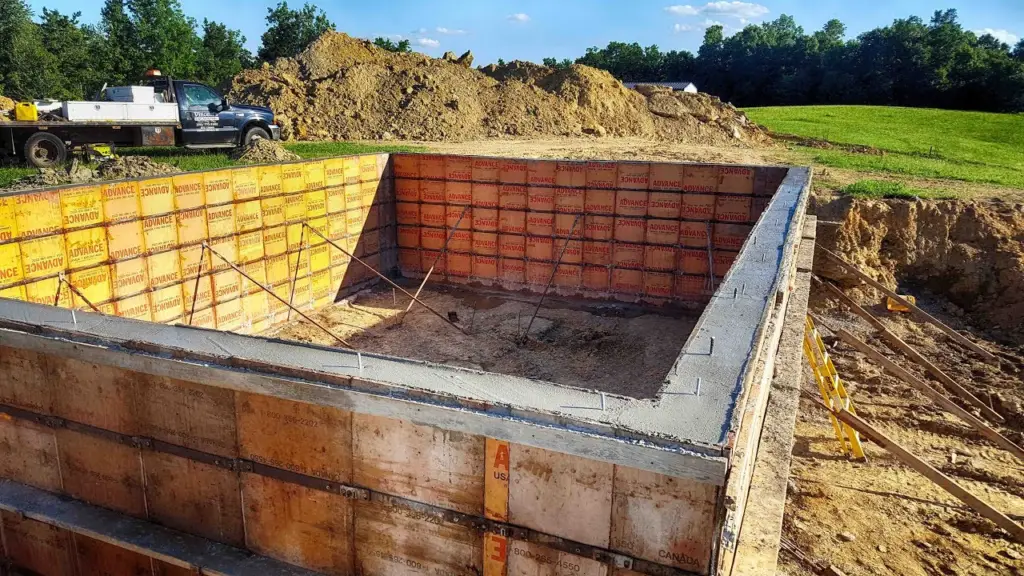The basement, once relegated to a damp and dark storage space, has undergone a transformation over the years. Today, it is considered an integral part of a home, offering not only additional square footage but also the potential for creating unique and functional living spaces. Basement construction and finishing have become popular endeavors, with homeowners recognizing the untapped potential beneath their feet. In this article, we will explore the intricacies of basement construction and finishing, delving into the reasons behind this process, the time it takes, and the crucial importance it holds for homeowners.

Unearth the Why: Reasons for Basement Construction and Finishing
1. Optimal Utilization of Space
Basements often start as neglected spaces, used primarily for storage or housing mechanical systems. Constructing and finishing a basement allows homeowners to maximize the utility of their property. Rather than leaving this valuable space untouched, it can be transformed into a variety of functional areas, such as a home office, a gym, a playroom, or even an additional bedroom.
2. Increased Property Value
A finished basement significantly enhances the overall value of a home. Potential buyers are increasingly seeking properties with versatile and well-utilized spaces. A professionally finished basement can set a home apart in the real estate market, potentially leading to a higher resale value. It’s an investment that not only improves your current living situation but also pays dividends in the future.
3. Expanded Living Space
As families grow or lifestyles change, the need for more living space becomes apparent. Rather than incurring the costs and hassles of moving to a larger home, basement finishing offers a cost-effective solution. This expansion of living space is especially crucial in urban areas where square footage comes at a premium.
4. Customization and Personalization
A basement provides a blank canvas for homeowners to express their creativity and design preferences. Whether it’s a home theater, a game room, or a stylish lounge, finishing a basement allows for complete customization. Homeowners can tailor the space to meet their unique needs and create an environment that aligns with their lifestyle.
The Journey: Basement Construction and Finishing Step by Step
1. Assessment and Planning
The journey to a finished basement begins with a thorough assessment of the space. Homeowners need to consider factors such as moisture levels, insulation, and structural integrity. Once the assessment is complete, a comprehensive plan is developed, outlining the intended use of the space and the necessary modifications.
2. Foundation Repair and Waterproofing
Before finishing the basement, any existing issues with the foundation must be addressed. Cracks, leaks, and other structural issues are repaired to ensure a solid foundation for the upcoming construction. Waterproofing measures are also implemented to protect the finished space from potential moisture problems.
3. Framing and Insulation
Framing is a crucial step in defining the layout of the finished basement. It involves creating the basic structure of walls, ceilings, and partitions. Insulation is then installed to regulate temperature and provide energy efficiency. Proper insulation is essential for creating a comfortable and habitable space.
4. Electrical and Plumbing
Once the framing is in place, electrical and plumbing systems are installed according to the design plan. This includes wiring for lighting, outlets, and any necessary plumbing fixtures. Careful planning in this phase ensures that the finished basement meets the electrical and plumbing needs of its intended use.
Like Us on Facebook!
5. Drywall Installation
The installation of drywall follows the completion of electrical and plumbing work. Drywall provides the finishing touch to the structural framework, creating smooth and even walls. This is a transformative phase, giving the space a more polished and refined appearance.
Subscribe Us on YouTube!
6. Flooring Installation
The choice of flooring depends on the intended use of the space. Options range from carpeting and hardwood to laminate and tile. The flooring installation is a critical aspect of the finishing process, adding both aesthetic appeal and functionality to the basement.
7. Painting and Finishing Touches
The final steps involve painting the walls and adding finishing touches. This includes trim work, moldings, and any additional decorative elements. Choosing the right colors and textures can significantly impact the overall atmosphere of the finished basement.
The Time Factor: How Long Does Basement Finishing Take?
Basement finishing is a comprehensive process that requires careful planning and execution. While the duration can vary based on factors such as the size of the basement, the scope of work, and any unexpected challenges, a typical timeline for finishing a basement ranges from 7 to 10 weeks. Let’s break down the time frame into key stages:
1. Preparation and Planning
This stage involves the initial assessment, planning, and obtaining any necessary permits. It sets the foundation for the entire project, ensuring that all aspects are considered before construction begins.
2. Foundation Repair and Waterproofing
Addressing foundation issues and implementing waterproofing measures can be time-consuming, but it is a crucial step to ensure the longevity and integrity of the finished space.
3. Framing and Insulation
The framing and insulation stage establishes the basic structure of the finished basement. Careful attention to detail is essential to guarantee a solid foundation for the subsequent phases.
4. Electrical and Plumbing
Installing electrical and plumbing systems requires precision and adherence to safety standards. Delays in this stage can impact the overall timeline, making it crucial to allocate sufficient time for these installations.
5. Drywall Installation
Drywall installation is a transformative phase that shapes the visual appearance of the finished basement. This stage includes taping, mudding, and sanding to achieve smooth and seamless walls.
6. Flooring Installation
The choice of flooring material and the intricacies of installation contribute to the overall timeline. Whether it’s carpeting, hardwood, or tile, the flooring stage adds the final touch to the basement.
7. Painting and Finishing Touches
The last phase involves painting the walls and adding finishing touches such as trim and moldings. This stage brings the entire project together, creating a polished and cohesive space.
The Significance of a Finished Basement: Beyond Aesthetics
1. Increased Property Value
The financial investment in basement construction and finishing often yields a high return. A finished basement can significantly boost the overall value of a home, providing a strong incentive for homeowners looking to sell or refinance.
2. Functional Versatility
A finished basement offers a versatile space that can adapt to changing needs. Whether it serves as an additional bedroom, a home office, or a recreational area, the functional versatility of a finished basement adds practicality to the home.
3. Enhanced Living Experience
Beyond the tangible benefits, a finished basement contributes to an enhanced living experience. It provides a retreat within the home, allowing homeowners to enjoy their personalized space for relaxation, entertainment, or work.
4. Energy Efficiency
Proper insulation and construction techniques contribute to the energy efficiency of a finished basement. This not only reduces utility costs but also enhances the overall sustainability of the home.
5. Environmental Considerations
Beyond the immediate benefits, a finished basement can also contribute to a more sustainable home. Proper insulation and construction techniques not only enhance energy efficiency but also reduce the overall environmental impact. A well-insulated basement helps regulate temperature, reducing the reliance on heating and cooling systems, ultimately lowering energy consumption.
6. Transforming Challenges into Opportunities
While the basement construction and finishing process may seem extensive, it also presents an opportunity for homeowners to address potential challenges and turn them into strengths. Issues such as moisture problems or foundation issues, if identified and resolved during the construction phase, can lead to a more durable and resilient living space.
7. The Role of Professional Guidance
Given the complexity of basement construction and finishing, seeking professional guidance is often crucial. Contractors with experience in basement projects can offer valuable insights, ensuring that the construction adheres to local building codes and safety standards. Their expertise can help homeowners navigate potential challenges and streamline the construction process.
8. Economic Considerations
In addition to the personal benefits, finished basements can contribute to the local economy. Homeowners engaging in basement construction often hire local contractors, purchase materials from nearby suppliers, and contribute to the growth of the construction industry. This economic impact extends beyond the individual homeowner, benefiting the community at large.
Conclusion
In the realm of home improvement, basement construction and finishing stand out as transformative endeavors. What was once a neglected space has evolved into a canvas for personal expression and practical utility.

















